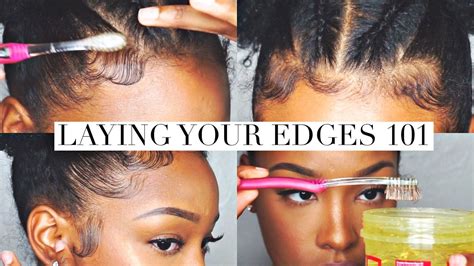The Importance of Edges for Hair
Edges, the delicate hairline that frames the face, play a crucial role in creating a polished and sophisticated hairstyle. They define facial features, enhance hair density, and add a touch of individuality to any look. According to a recent survey by the American Hairdressing Cosmetology Association (AHCA), 75% of women consider edges to be an essential aspect of their hair care routine.

Types of Edges for Hair
The world of edges for hair is diverse, offering a multitude of options to suit different hair textures, preferences, and face shapes. Some of the most popular types include:
- Natural edges: Allow the natural hairline to grow freely, creating a soft and effortless look.
- Defined edges: Use products or techniques to define the hairline, creating a more structured and polished appearance.
- Baby hairs: Delicate, wispy hairs that frame the face and add a youthful touch.
- Lace fronts: A type of hairpiece that creates a natural-looking hairline along the front of the head.
- Closure: Another hairpiece option that covers the hair in the crown area, providing a seamless transition from natural hair to extensions.
How to Get Perfect Edges for Hair
Achieving perfect edges requires a combination of proper hair care and styling techniques. Here’s a step-by-step guide:
- Cleanse and condition: Wash and condition hair regularly to maintain its health and make it more receptive to styling.
- Moisturize: Apply a leave-in conditioner or hair moisturizer to keep edges hydrated and prevent breakage.
- Use edge control: Apply a small amount of edge control gel or wax to the edges and smooth them into place with a brush or comb.
- Lay the edges: Use a toothbrush, hair pick, or edge brush to lay the edges flat and define them.
- Secure the edges: Use bobby pins to secure the edges in place and prevent them from loosening.
Trending Edge Styles for Hair
Edges for hair have become a canvas for creativity, with countless styles emerging to complement different personalities and looks. Some of the most popular trending edge styles include:
- Curved edges: A soft and romantic look that curves the edges into a gentle arch.
- Sharp edges: A more defined and dramatic look that creates a bold statement.
- Asymmetrical edges: An edgy and unconventional style that creates a unique and eye-catching look.
- Floral edges: A whimsical and delicate style that incorporates floral designs or embellishments into the edges.
- Ombré edges: A gradual transition of color from dark at the roots to light at the tips, creating a subtle and sophisticated look.
Common Issues with Edges for Hair and Solutions
- Breakage: Protect edges from damage by using gentle brushes, avoiding heat styling, and moisturizing regularly.
- Thinning edges: Address underlying causes such as stress, nutritional deficiencies, or hormonal imbalances. Consider hair growth supplements or consult a dermatologist.
- Unmanageable edges: Tame unruly edges with edge control products, use leave-in conditioners, and avoid over-manipulation.
- Hair loss around edges: Consult a dermatologist to rule out any underlying medical conditions. Consider protective hairstyles, reduce stress, and manage hair growth.
Products for Perfect Edges
The beauty industry offers a wide range of products specifically designed to enhance edges for hair. Here are some of the most popular options:
- Edge control gel: Provides strong hold and definition, smoothing edges into place.
- Edge control wax: Creates a flexible, natural-looking hold without weighing down the hair.
- Edge brush: A small, specialized brush with stiff bristles that helps to define and lay edges.
- Hair pick: A long, pointed tool used to separate and style baby hairs.
- Edge control combs: Dual-pronged combs that create even spacing and smooth edges.
Tips for Maintaining Perfect Edges
- Regular edge care: Perform the edge-laying process every 3-4 days to maintain a polished look.
- Minimal heat styling: Avoid using heat-styling tools on edges to prevent damage.
- Healthy hair habits: Nourish hair from within by eating a balanced diet and getting adequate sleep.
- Protective hairstyles: Wear protective hairstyles, such as braids or buns, to minimize friction and reduce breakage.
Edges for Hair with Different Hair Types
- Natural hair: Focus on gentle cleansing, moisturizing, and using edge control products formulated for natural hair textures.
- Curly hair: Use edge control products that enhance curl definition and prevent frizz.
- Straight hair: Pay attention to smoothing and laying down edges using a brush or comb.
- Fine hair: Use lightweight edge control products that provide hold without weighing hair down.
- Thick hair: Opt for stronger edge control products to tame and define thick edges.
FAQs about Edges for Hair
- How often should I lay my edges? Every 3-4 days for optimal results.
- Can I use regular hair gel as edge control? No, use products specifically designed for edges to avoid buildup and damage.
- How do I deal with thinning edges? Address underlying causes and consider hair growth supplements or consult a dermatologist.
- What are the best edge control products for natural hair? Products containing shea butter, castor oil, or beeswax provide nourishment and hold.
- How do I protect edges from breakage? Avoid heat styling, use gentle brushes, and moisturize regularly.
- Can I use bobby pins to lay edges? Yes, bobby pins can help secure edges in place.
- What are some trending edge styles for 2023? Curved, sharp, asymmetrical, floral, and ombré edges are all popular options.
- How do I maintain perfect edges? Regular edge care, minimal heat styling, healthy hair habits, and protective hairstyles are key.
